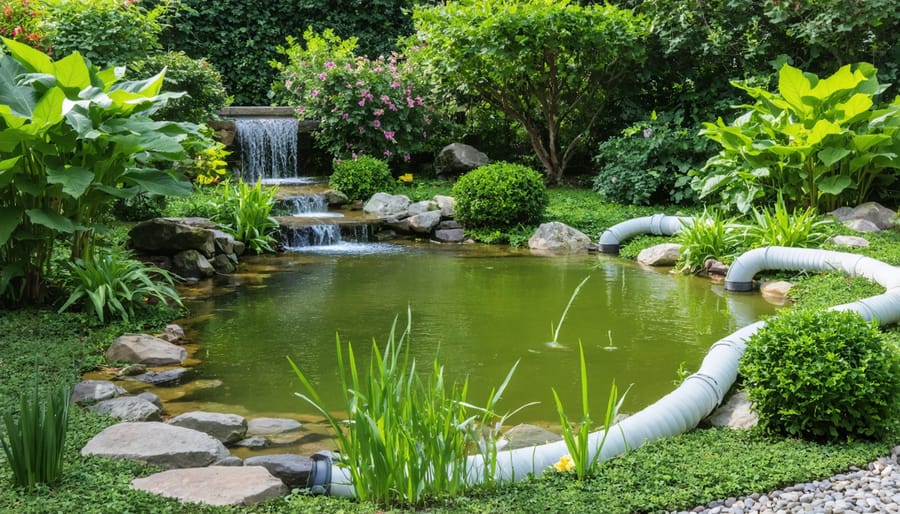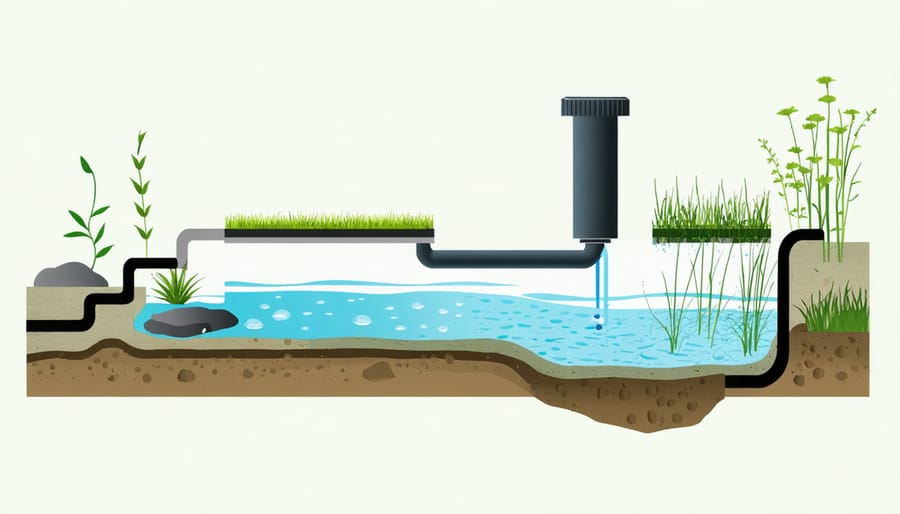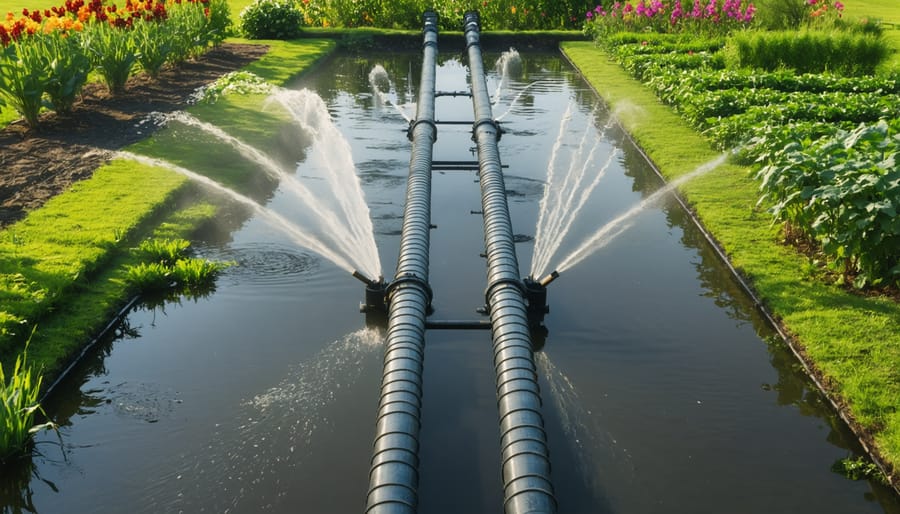
Quench Your Garden’s Thirst: 5 Secrets to Effortless Pond Irrigation
Choose a pond location with adequate water supply, proper soil composition, and minimal erosion risk to ensure a sustainable irrigation source. Install a reliable pump system with sufficient capacity to deliver water at the required pressure and volume for your irrigation needs. Design an efficient distribution network using pipes, valves, and sprinklers to evenly water your crops or landscaping while minimizing water loss. Regularly monitor and maintain your pond irrigation system, checking for leaks, clogs, or equipment malfunctions to keep it operating at peak performance.
The Power of Pond Placement

Elevation Matters
When it comes to irrigating from a pond, elevation plays a crucial role in determining water pressure and flow. The higher your pond is relative to the area you want to irrigate, the more pressure you’ll have, allowing water to travel further with less effort. Conversely, if your pond is at a lower elevation, you may need to use a pump to generate sufficient pressure for effective irrigation.
To optimize water flow, consider the distance and height difference between your pond and the irrigation target. Gravity is your friend here – the greater the elevation difference, the more natural pressure you’ll have. This can save energy and reduce the need for additional pumping.
When designing your pond irrigation system, take into account the pond’s location and how it relates to the surrounding landscape. Careful planning can help you harness the power of elevation to create an efficient and sustainable watering solution for your garden oasis.
Proximity to Your Garden
Having your pond in close proximity to your garden offers several advantages when it comes to irrigation. The shorter the distance between the water source and the plants, the less energy and infrastructure required to transport the water. This translates to lower costs for pumps, pipes, and other equipment. It also means less water loss due to evaporation and leakage along the way.
With a nearby pond, you can easily monitor the water level and quality, ensuring a consistent supply for your plants. You’ll spend less time hauling hoses or watering cans, and more time enjoying your thriving garden. Plus, the presence of a pond enhances the overall aesthetic of your outdoor space, creating a beautiful and relaxing environment.
Whether you have a small vegetable patch or a sprawling landscape, positioning your pond close to the action simplifies irrigation and maximizes the benefits of this natural water source.

Picking the Perfect Pump
Pump Sizing 101
To determine the right pump size for your pond irrigation system, consider the pond’s volume and your watering needs. Calculate the pond’s volume in gallons by multiplying its average length, width, and depth in feet, then multiply by 7.48. For example, a pond measuring 20’L x 10’W x 5’D would hold approximately 7,480 gallons.
Next, assess your irrigation requirements. A small garden may only need 100-200 gallons per hour (GPH), while larger areas could require 1000+ GPH. Choose a pump that can move at least half of your pond’s volume per hour. For the 7,480-gallon pond, a 3000-4000 GPH pump would be suitable.
Also, factor in the pump’s “head height” – the vertical distance it needs to push water. Pumps lose efficiency as head height increases, so select one with enough power to overcome elevation changes. Consult pump performance charts to find the perfect match for your pond size and head height requirements.
Efficiency is Key
When selecting a pump for your pond irrigation system, prioritize energy efficiency to minimize operating costs. Look for pumps with high energy ratings and features like variable speed motors that adjust power consumption based on demand. While an energy-efficient pump may have a higher upfront cost, it will save you money in the long run through reduced electricity bills. Consider the pump’s flow rate and pressure requirements for your specific irrigation needs, and choose a model that meets those requirements without exceeding them, as oversized pumps waste energy. Investing in an efficient pump ensures your pond irrigation system runs cost-effectively season after season.
Designing Your Dream Irrigation Layout
Mapping Your Masterpiece
To map out your pond irrigation layout, start by sketching your garden’s dimensions on paper or using a digital design tool. Mark the location of your pond and any existing features like trees, shrubs, or paths. Consider the size and shape of your garden beds and determine where you want to direct the water flow.
Next, plan the placement of your pump, pipes, and sprinklers or drip lines. Ensure the pump is positioned near the pond’s edge for easy access and maintenance. Sketch out the route for the main supply line, keeping it as straight as possible to minimize friction loss. From there, branch off with smaller lines to reach each section of your garden.
When designing your layout, factor in the water pressure and flow rate needed to efficiently irrigate your plants. This will help you select the right pump size and determine the optimal number and spacing of sprinklers or drip emitters. Remember to include natural filtration and external filters in your pond setup to maintain water quality for your irrigation system.
With a well-mapped plan, you’ll be ready to bring your pond irrigation masterpiece to life and enjoy a thriving, efficiently watered garden.

Pipe Dreams Made Real
To bring your pond irrigation dreams to life, you’ll need the right pipes and fittings. PVC pipes are a popular choice for their durability and affordability. For optimal flow, opt for pipes with a diameter of 1-2 inches. When it comes to fittings, you’ll need elbows, tees, and couplings to create the desired layout. Don’t forget to include a check valve to prevent water from flowing back into the pond.
To assemble your irrigation system, start by laying out the pipes according to your design. Use PVC primer and cement to securely join the pipes and fittings together. Make sure to allow sufficient drying time before testing the system. When connecting the pipes to your pump, use a flexible hose to allow for easier positioning and adjustments.
For a seamless installation, consider using a combination of rigid and flexible pipes. This will enable you to navigate around obstacles and create a custom layout that suits your garden’s unique needs. With the right pipes and fittings, you’ll be well on your way to creating a reliable and efficient pond irrigation system that will keep your plants thriving.
Emitter Essentials
Emitters are the key components that deliver water to your plants in a pond irrigation system. The two main types are drip emitters and micro-sprayers. Drip emitters release water slowly and directly to the roots, perfect for plants that prefer consistent moisture. Micro-sprayers cover a wider area with a fine mist, ideal for plants that thrive in humid environments or have shallow roots. When choosing emitters, consider each plant’s water requirements, root depth, and foliage density. Adjustable emitters allow you to fine-tune the flow rate for each plant’s specific needs. Mix and match emitter types to create a customized watering solution that keeps your pond-side garden lush and thriving.
Maintaining Your Pond Irrigation Paradise
Crystal Clear Water Wonders
Maintaining a clean and healthy pond is essential for a thriving irrigation system. To prevent algae growth and keep the water crystal clear, there are several maintenance techniques you can employ. First, ensure your pond has proper filtration and aeration systems in place. Regularly clean the filters and remove any debris that may accumulate. Consider adding beneficial bacteria to your pond, which help break down organic matter and compete with algae for nutrients. Planting a variety of aquatic plants can also help absorb excess nutrients and provide shade, limiting algae growth. Maintain a balanced ecosystem by avoiding overfeeding fish and removing any decaying plant matter. If necessary, use pond dyes or barley straw to control algae growth naturally. By dedicating time to these maintenance practices and monitoring your pond’s water quality, you’ll enjoy a crystal clear water wonder that not only looks beautiful but also provides a reliable source for your irrigation needs.
Pump and Pipe TLC
To keep your pump and pipes in top shape, regular maintenance is key. Check the pump intake screen for debris and clean it out at least once a week to prevent clogs. If you notice reduced water flow, the pipes may be partially blocked. Flush the lines by disconnecting the end and running water through at full pressure. For stubborn clogs, use a plumber’s snake or a long, flexible brush. Inspect pipes for leaks or damage and repair promptly to avoid wasting water and stressing your pump. In colder climates, drain the pipes before the first frost to prevent cracking. Consider installing a timer on your pump to automate irrigation and extend its lifespan by preventing overwork. With a little TLC, your pump and pipes will efficiently deliver water to your garden season after season.
Troubleshooting Tips for Tranquil Irrigation
When Flow is Low
Low water flow in your pond can be caused by several factors, such as clogged pipes, malfunctioning pumps, or leaks in the system. To identify the issue, start by inspecting the intake and discharge pipes for any blockages or debris. Next, check your pump to ensure it’s functioning properly and not overheating. If you suspect a leak, examine the entire system for signs of water loss or pooling. Once you’ve identified the problem, take the necessary steps to fix it, whether that means clearing obstructions, replacing worn parts, or sealing leaks. Regular maintenance and prompt repairs will keep your pond irrigation system running smoothly and efficiently.
Leaky Line Fixes
To identify leaks in your irrigation pipes, regularly inspect the lines for wet spots or puddles. You may also notice a decrease in water pressure or an increase in your water bill. To fix small leaks, turn off the water supply and use a pipe repair kit or waterproof tape to seal the damaged area. For larger leaks or breaks, you may need to replace the affected section of pipe. Cut out the damaged portion using a hacksaw or pipe cutter, then insert a new piece of pipe using slip couplings or PVC cement. Test the repair before covering the pipes with soil.
Conclusion
Pond irrigation is a highly effective and eco-friendly way to keep your garden thriving. By harnessing the power of your pond’s natural water source, you can create a self-sustaining irrigation system that saves time, money, and precious resources. The key benefits of pond irrigation include reduced water bills, healthier plants, and a more vibrant, lush landscape. With the right location, equipment, and maintenance practices, you can unlock the full potential of your pond and enjoy a beautiful, flourishing garden for years to come. So why not implement these secrets in your own outdoor oasis? Start exploring the wonders of pond irrigation today and discover the joy of nurturing your garden with the help of nature’s own life-giving waters.
